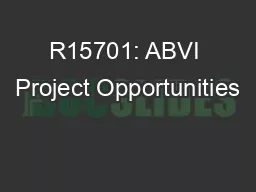

Sabrina Caliri Thomas Visalli Joseph Lee Christine Lochner Ian Nanney Courtney Smith Kenneth Wilkinson Voice of Customer Presentation GoalMission Statement Increase business potential create jobs and generate revenue for ABVI ID: 399676
Download Presentation The PPT/PDF document "R15701: ABVI Project Opportunities" is the property of its rightful owner. Permission is granted to download and print the materials on this web site for personal, non-commercial use only, and to display it on your personal computer provided you do not modify the materials and that you retain all copyright notices contained in the materials. By downloading content from our website, you accept the terms of this agreement.
Slide1
R15701: ABVI Project OpportunitiesSabrina Caliri, Thomas Visalli, Joseph Lee, Christine Lochner, Ian Nanney, Courtney Smith, Kenneth Wilkinson
Voice of Customer PresentationSlide2
Goal/Mission StatementIncrease business potential, create jobs and generate revenue for ABVI
Objectives
Identify potential soft goods manufacturing operations that ABVI could add to current production capabilitiesIdentify and evaluate potential upcycling techniques to maximize donation value of bulk textile materials. Identify characteristics (i.e. capabilities, layout, procedures)Identify potential areas for improvement based on these characteristicsState consumer problems, and define the nature of product/service opportunities that are created by those problems.
Project DescriptionSlide3
Primary StakeholderJoe Kells director of sales and business development ABVI
Secondary Stakeholder
Employees of ABVIGeneral Population of People with visibility disabilitiesFamily members of the visually impairedRIT CommunityGerald GaravusoDPL ABVI Team
MSD Team assigned
StakeholdersSlide4
ABVI has a long term goal to enhance the lives of the visually impaired. AVBI is looking to expand on their existing revenues sources by creating new product to compete nationally. These products can either be new softgood produces or new processed textiles.
Softgoods Production
New material is sewed into a finished product.
The finished product is of high quality.
Purchase additional machines if proven to increase profit.
Both
ABVI maintains status of having high integrity and consciousness.
The final products needs to have a reliable and sustained market for product viability.
The process is competitive in the US market and potentially in the global market.
The process increases employment opportunities for the blind and visually impaired community.
Utilize existing resources.
Upcycling Textile
ABVI will upcycle the material instead of selling it to an outside manufacturer to upcycle.
One Goodwill location per region will grind up the textiles for that region.
Compare the profitability of selling the shredded material vs. processing further to create a product.
Shredder should look for product opportunities to increase the value of the shredded fabric
Objective TreeSlide5
Objective Tree
Goal
Affinity GroupCustomer Objective DescriptionIncrease business potential, create jobs, and generate revenue for ABVI
Capabilities
Utilize existing resources.
The process increases employment opportunities for the blind and visually impaired community.
Create pilot upcycling program at Rochester ABVI location
The recycling manufacturing process is operational by the visually impaired community.
Shredder should look for product opportunities to increase the value of the shredded fabric (Sound deadening, insulation, cotton based non apparel, paper).
Separating specific fabrics, turning shredded material back into thread or other useful commodities
New material is sewed into a finished product.
The finished product is of high quality.
Business Goals
The process is competitive in the US market and potentially in the global market.
Project expands customer base.
Quick return on investment (TTM).
ABVI maintains status of having high integrity and consciousness.
The final products need to have a reliable and sustained market for product viability.
Usage
ABVI will upcycle the material instead of selling it to an outside manufacturer to upcycle.
The recycling process needs to maximize profit per pound of donated material.
The upcycling process needs to be more profitable than selling the material to a secondary company.
Purchase additional machines if proven to increase profit.
Manufacturing utilizes current machinery.
Resources
A total of 400 million pounds of textiles from Goodwills all over the country need to be recycled .
One Goodwill location per region will grind up the textiles for that region.
Process uses pre-cut material for sewing.
Utilizes a workforce of 20-30 skilled workers or more.
Legend
Both
Textiles
SoftgoodsSlide6
Customer Requirements
Project
CategoryNeed #Importance
Description
Both
Expand Current Business Capabilities
CR1
Important
Project expands customer base.
CR2
Desired
Utilize existing resources.
CR3
Desired
The process increases employment opportunities for the blind and visually impaired community.
Increase Profitability
CR4
Important
The process is competitive in the US market and potentially in the global market.
CR5
Critical
Quick return on investment (TTM).
Ethics
CR6
Critical
ABVI maintains status of having high integrity and consciousness.
CR7
Critical
The final products need to have a reliable and sustained market for product viability.
Textiles
Usage
CR8
Important
ABVI will upcycle the material instead of selling it to an outside manufacturer to upcycle.
CR9
Critical
The recycling process needs to maximize profit per pound of donated material.
CR10
Critical
The upcycling process needs to be more profitable than selling the material to a secondary company.
Resources
CR11
Desirable
A total of 400 million pounds of textiles from Goodwills all over the country need to be recycled .
CR12
Desirable
One Goodwill location per region will grind up the textiles for that region.
Capabilities
CR13
Desirable
Create pilot upcycling program at Rochester ABVI location
CR14
Critical
The recycling manufacturing process is operational by the visually impaired community.
CR15
Critical
Shredder should look for product opportunities to increase the value of the shredded fabric (Sound deadening, insulation, cotton based non apparel, paper).
CR16
Critical
Separating specific fabrics, turning shredded material back into thread or other useful commodities
Softgoods
Usage
CR17
Desirable
Purchase additional machines if proven to increase profit.
CR18
Desirable
Manufacturing utilizes current machinery.
Resource
CR19
Important
Process uses pre-cut material for sewing.
CR20
Critical
Utilizes a workforce of 20-30 skilled workers or more.
Capabilities
CR21
Important
New material is sewed into a finished product.
CR22
Critical
The finished product is of high quality.Slide7
Additional CommentsSlide8
Do you have any ideas for high end softgood products ABVI could create?Do you have any suggestions for uses of grinded cotton materials?
Questions